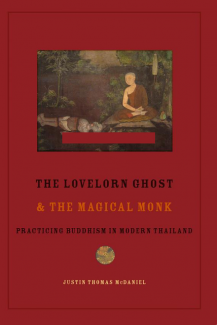The Lovelorn Ghost and the Magical Monk: Practicing Buddhism in Modern Thailand
Justin McDaniel
2011
Columbia University Press
Stories centering on the lovelorn ghost (Mae Nak) and the magical monk (Somdet To) are central to Thai Buddhism. Historically important and emotionally resonant, these characters appeal to every class of follower. Metaphorically and rhetorically powerful, they invite constant reimagining across time.
Focusing on representations of the ghost and monk from the late eighteenth century to the present, Justin Thomas McDaniel builds a case for interpreting modern Thai Buddhist practice through the movements of these transformative figures. He follows embodiments of the ghost and monk in a variety of genres and media, including biography, film, television, drama, ritual, art, liturgy, and the Internet. Sourcing nuns, monks, laypeople, and royalty, he shows how relations with these figures have been instrumental in crafting histories and modernities. McDaniel is especially interested in local conceptions of being “Buddhist” and the formation and transmission of such identities across different venues and technologies.
Establishing an individual’s “religious repertoire” as a valid category of study, McDaniel explores the performance of Buddhist thought and ritual through practices of magic, prognostication, image production, sacred protection, and deity and ghost worship, and clarifies the meaning of multiple cultural configurations. Listening to popular Thai Buddhist ghost stories, visiting crowded shrines and temples, he finds concepts of attachment, love, wealth, beauty, entertainment, graciousness, security, and nationalism all spring from engagement with the ghost and the monk and are as vital to the making of Thai Buddhism as venerating the Buddha himself.

